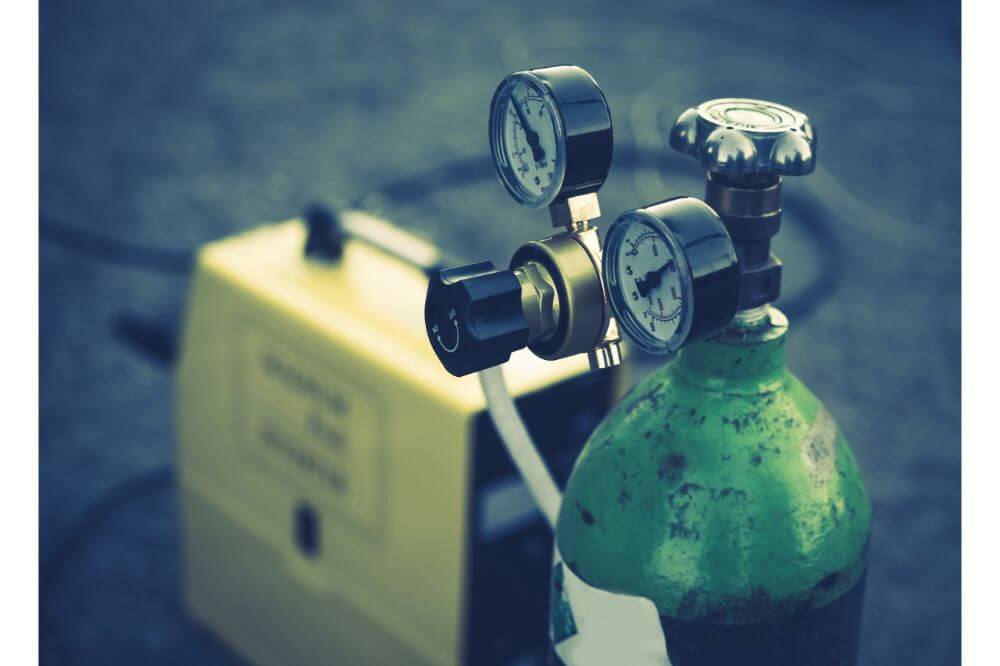A MIG welder is a special type of welder used for many common welding purposes.
Technically this type of welding is also referred to as GMAW (gas metal arc welding), and MIG stands for metal inert gas. This is a type of welder that can be used to weld thin and medium-thick base metals together.
These welders can join various metals such as carbon steel, stainless steel, aluminum, magnesium, copper, nickel, silicon bronze, and other alloys.
As you may have noticed, the word ‘gas’ is used, and there is a good reason for it. In this article, we will discuss why MIG welders use gas, what types of gas are used, and how to set the gas flow on a MIG welder.
Why do MIG Welders Use Gas?
MIG welders use gas throughout the welding process, but why is this the case? These gases are known as shielding gases and their main purpose is to prevent the molten welding pool from being exposed to oxygen, nitrogen, and hydrogen, all gases which are present in our atmosphere.
If oxygen, nitrogen, or hydrogen come in contact with the metal pool, it can create a reaction, with the results being holes in the welding bead, excessive spatter, and other dangerous issues. Various shielding gases can be used for MIG welding, so the first step is to choose the right gas for the job.

Choosing the Right Shielding Gas – Types of Shielding Gas
There are four main types of gases used in MIG welding – helium and argon, as well as carbon dioxide and oxygen. These gases are often used in combination.
- If you are welding aluminum, the best gas to use is argon, but if the aluminum being welded is thicker than ½ inch, you may need to use a combination of argon and helium
- For welding stainless steel, a C2 mixture is typical (2% CO2 and 98% argon). You may also use a combination of 90% helium, 7.5% argon, and 2.5% CO2
- For carbon steel welding, most people use pure CO2. However, you may also use C25, which is a mixture of 25% CO2 and 75% argon
Setting Up and Adjusting the Gas on a MIG Welder
Now that you know what kind of gas to use for your MIG welding, it is time to set up the gas flow. We want to stress that using these gases can be dangerous in some circumstances, so always use extreme caution when working with them.
First and foremost, when using a shielding gas for MIG welding, always make sure that the shielding gas cylinder is well secured with something like a chain; you do not want it falling over, particularly during use.
If you are not using a shielding gas, make sure that you have the cap on the valve as a safety precaution.
A flow gauge tells you how much pressure is being put on the tubing. Get a good flow gauge and attach it to the nozzle of the shielding gas cylinder. When attaching the flow gauge, make sure that the cylinder is closed. A dual gauge is best, as one gauge tells you how much gas is in the cylinder, and the second tells you how much gas is flowing through the tubing. The flow gauge is should be installed on the cylinder in the vertical position.
Now, attach the gas intake tube from the MIG welder to the flow gauge, ensuring that it is tightly secured; you don’t want any gas leaking out, or else it will not work properly.
Now that everything is securely connected, open up the cylinder and the flow valve slowly, and open it all the way to allow for maximum gas flow.
Now, you can use the adjustment valve on the flow gauge to slowly close the valve until you get the right CFH reading. For most welding purposes, a CFH of 15 to 25 is ideal.
Something to keep in mind is that the flow rate you need depends on the type of welder you are using and the nozzle that is attached to it. Here are some general tips for getting the right flow.
- For 3/8-inch nozzles, the ideal flow setting is between 18 and 22 CFH
- For ½-inch nozzles, the ideal flow setting is between 22 and 27 CFH
- For 5/8-inch nozzles, the ideal flow setting is between 30 and 25 CFH
- For ¾-inch nozzles, the ideal flow setting is between 30 and 40 CFH
Conclusion
The most important thing for you to remember is to be safe, and if you are unsure of what you are doing, always ask for help from a professional.

